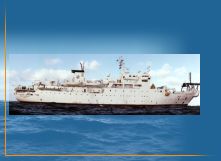| Home | Submarine cable network | Laying, burying and maintenance cables | Fishing activities | Fishing vessels |

The cable ship fleet

Orange has its own cable shipping fleet. Further details are available at the following site :
http://marine.orange.com/Other operators also have their own cabling fleets :

Laying, burying, and maintenance of cables
Laying
LayingOcean floor surveys are consulted at the outset to establish the optimal route for cables along the seabed. Any obstacles lying in their path (such as wrecks, for example) are identified, and the quality of the ocean floor in the various areas is assessed.
In addition, at the point where the cable lands, the diverse parties affected by the cable's route are consulted and invited to participate in meetings to discuss the implications of the cable's path.
Fishing vessel owners in particular, and those to whom they report, are encouraged to participate in these meetings to decide on the best route for the cable. The main aim is of course to achieve maximum protection for the cables, but also to cause the least disturbance possible to coastal marine activity.
Where the seabed permits, cables are buried by means of a plough towed along by the cable ship. Robots may also be involved in the burying procedure. The depth of the trench varies according to the quality of the seafloor. It can be anywhere from 0 to 110 cms. Sometimes, it may be as deep as 250 cms. The speed of the ship during the burying process is approximately 0.5 knots.
The repeaters have a larger diameter than the rest of the cable, and so are more difficult to bury, and hence pose more of a risk as far as hooking is concerned.
Cable maintenance
As soon as a cable deteriorates, it must be repaired. Repairs are also carried out on the cable ship. The damaged part of the cable has to be fished out of the water and cut. The damaged parts are removed, and a longer piece of cable than the piece removed is then inserted - the extra length is calculated as a function of the ocean depth at the repair point.At each stage of the repair project, a series of measurements is taken to qualify the work in progress.
A post-repair report on any perturbations encountered is conducted for about 5 to 10 days following the repair.
The cable ship remains operational 24 hours a day in normal weather conditions.When a trawling hook event occurs it is not infrequently the case that the cable pulled up for repair is found to be swollen and twisted, with debris attached of some volume (sometimes, several cubic metres). This can be caused by the different manoeuvres used when pulling up the cable, and the very high tension applied to the cable by the trawler when it hooked on to it.
Following repairs to a cable, the cable is left to rest. When put back into the water, the cable's original depth means that there will inevitably be a certain amount of slack in the part which was recovered. This slack will be impossible to bury, and may give rise to segments of cable recovered as high as 1 metre above the rest of the cable. These cable segments will evidently be points of vulnerability.
These loops are similar to those formed in a warp that has undergone an abnormal tension over a sharp angle (the hull of a ship, for example).
Loops can occur together to form a spiral of considerable length on the seabed.THESE ZONES ARE IDENTIFIED AS HIGH RISK HOOKING ZONES.
THESE HIGH RISK SNAGGING ZONES MUST BE AVOIDED BECAUSE THERE IS SIGNIFICANT RISK OF HOOKING









